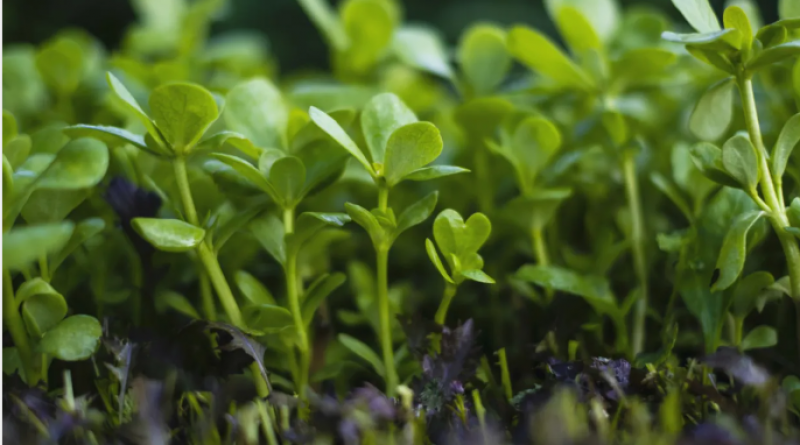15 Indigenous Crops to Boost Your Immune System and Celebrate Biodiversity.

This Friday, May 22, marks the International Day for Biological Diversity. Every year, the United Nations uses this day as an opportunity both to celebrate the Earth's stunning biodiversity and to recognize our task to protect it.
Unfortunately, due to biodiversity loss from industrialization and unsustainable land use, the planet's health is threatened. Nearly a quarter of wild food species—plant and animal—are decreasing in abundance, according to the U.N. Food and Agriculture Organization. Biodiversity is not only important for the planet—but it's important for human health, too. Eating a range of fresh fruits, vegetables, and whole grains can help immune systems by providing the full range of nutrients, from vitamins C and D to zinc and iron. And COVID-19 is revealing the urgency of improving immunity—and the power of food to protect us.
"There's a range of vitamins, of flavanols, of minerals that have been looked at, that we know improve the immune system function. … Several specific nutrients seem to have activity against COVID-19-specific proteins," Dr. Dariush Mozaffarian, a cardiologist and the dean of the Tufts University Friedman School of Nutrition Science and Policy, told me on Food Talk Live this week. "What's really interesting, beyond the general immune-boosting effects and the COVID-specific protein effects, many of these same nutrients or other nutrients blunt or soften this excessive inflammatory response that's really what's causing deaths in COVID."
These 15 indigenous crops, among countless others, are prized in traditional agriculture systems for their resiliency, diversity, versatility, and most of all, nutritious value.
1. Amaranth (Amaranthus)
The more than 75 species of amaranth grow across nearly every continent, from the humid lowlands of Africa to mountainous countries in South America. Amaranth, which grows quickly in hot weather, is cultivated both as a leafy green and a cereal-like grain. It's an excellent source of protein, vitamins, and essential minerals, including calcium, iron, magnesium, potassium, and zinc.
2. Arracacha (Arracacia xanthorrhiza)
An important South American root crop, Arracacha is best described as somewhere between a carrot and celery root. It was originally cultivated in the Andes, but because of its versatility and low-input costs, is now an important crop in many lower regions of Brazil, Colombia, and Venezuela. Arracacha is typically prepared similarly to potatoes, but contains four times the calcium as potatoes and significant carotenoid pigments, the precursor to vitamin A.
3. Bay of Fundy Dulse (Palmaria palmata)
Dulse is a red seaweed that's been used for culinary and medicinal purposes across Ireland, Iceland, and Canada's Atlantic coast. Dulse that grows in the Bay of Fundy, between the provinces of New Brunswick and Nova Scotia, was once a popular snack food and an important ingredient in traditional chowders and stews for many First Nations communities. Dulse has a high protein content, and contains iodine, iron, and many other trace vitamins and minerals.
4. Chaya (Cnidoscolus aconitifolius)
Chaya, an evergreen plant native to the Yucatán Peninsula of Mexico, has been a staple of indigenous diets for centuries in Mexico and Central America. Chaya grows very easily and is resistant to insects, heavy rains, and droughts. The leaves must be cooked to be safe to eat, but chaya is rich in protein, vitamins A and C, calcium, iron, phosphorus, and many minerals and enzymes.
5. Chayote (Sechium edule)
The chayote, a green, pear-shaped member of the squash family, has been an important part of diets across mesoamerica since pre-Columbian times. The plant is extremely versatile and can be grown in warm climates from sea level to more than 2000 meters above sea level. Most parts of the plant may be eaten, including the fruit, stems, and leaves, and it's a good source of vitamin C and folate.
6. Desert Lime (Citrus glauca)
Desert lime grows naturally in the semi-arid regions in eastern Australia in a range of soil types. It is tolerant of heat, frost, drought, and salinity, and it can withstand extreme temperature conditions from -12 degrees C to 45 degrees C (10.4 degrees F to 113 degrees F). Desert lime has high levels of vitamin C, folate, calcium, and antioxidants.
7. Fonio (Digitaria)
The two species of fonio — white and black — grown across West Africa are versatile and gluten-free varieties of millet. Fonio is fast-growing and suitable for dry conditions, although very labor-intensive to harvest. The grain has been cited as a path toward greater food security in Africa and is high in iron, calcium, and several essential amino acids.
8. Kakadu Plum (Terminalia ferdinandiana)
The Kakadu Plum—also called the Gubinge, Billygoat Plum, or Murunga—grows across northern Australia and has the highest recorded natural vitamin C content of any plant in the world. Suited to its natural hot and coastal environment, the kakadu plum can grow in a variety of dry and saline habitats, from dry creek beds to cliff tops and ridges.
9. Kumara/Sweet Potato (Ipomoea batatas)
Sweet potatoes, also known as kumara in many Polynesian languages and in New Zealand's indigenous Māori language, are a staple crop across Africa, Asia, and many cultures within and surrounding the Pacific Ocean. The starchy vegetable is a great source of protein, vitamins A and C, iron, calcium, and dietary fiber.
10. Målselvnepe Turnip (Brassica rapa subsp. rapa)
This old Norwegian landrace of turnip has been improved over the years through selective cultivation. It has an excellent, yet strong and distinct, taste compared to other turnip varieties. It can be eaten raw, roasted, baked, and boiled, and is frequently used to enhance the flavor of soups, salads, stir-fries, and side dishes. The Målselvnepe turnip is an excellent source of vitamin C and potassium.
11. Mung Bean (Vigna radiata)
The mung bean is important in Asian diets and valuable for its easily digestible protein. High levels of iron in the vegetable help improve the diets of the most vulnerable women and children, and mung bean production offers an opportunity for increased income for small-scale farmers. The vegetable can also fix nitrogen in the soil, making it valuable for crop rotations.
12. Northern Wild Rice (Zizania palustris)
Northern wild rice (manoomin in Anishinaabe languages), one of four global wild rice species, grows across the Great Lakes region in the U.S. and in aquatic areas of Canada's Boreal Forest. Wild rice has been central to Indigenous foodways in the region, particularly in Minnesota, for millennia. Although it is now domesticated and cultivated largely for commercial sale, much of it is still harvested using traditional methods. Wild rice is rich in vitamins, minerals, antioxidants, and fiber, and contains more protein than most other whole grains.
13. Pawpaw (Asimina triloba)
The pawpaw fruit is the largest edible fruit indigenous to North America, and has a tropical flavor reminiscent of a mix between mangoes and bananas. It was grown and eaten by Native Americans and early European settlers, although it has proven difficult to commercialize due to its very short shelf life after harvesting. However, the fruit is high in vitamin C, magnesium, and iron, and also contains some vitamin A.
14. Purslane (Portulaca oleracea)
Since prehistoric times, purslane has been grown by humans around the world, from Australia to the Middle East to Asia. It's still common in Mediterranean countries and in aboriginal Australian foodways. Purslane is capable of CAM photosynthesis in extreme conditions, which allows the plant to grow while saving water, making it a very successful plant across many climates. Purslane also contains more essential omega-3 fatty acids than any other leafy green, and the plant is also extraordinarily high in vitamin E.
15. Tepary Beans (Phaseolus acutifolius)
Tepary beans have been a staple crop for thousands of years and remain important for Indigenous farmers across North America, including in Tohono O'odham communities in the American southwest. They grow quickly in arid desert conditions and are resistant to alkaline soils, making them one of the most drought- and heat-tolerant crops in the world. Although related to standard beans, tepary beans actually contain more protein, calcium, fiber, iron, and zinc, and have a low glycemic index.
21 May 2020
EcoWatch



